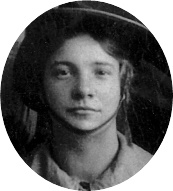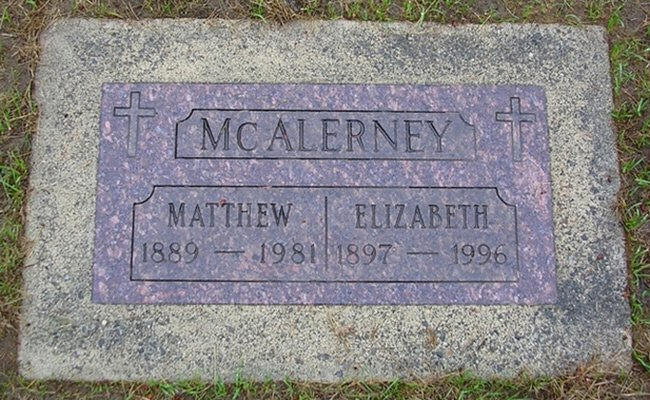Elizabeth `Lily’
Kempson (1897 - 1996)
Irish Patriot, Labor
Activist, Citizen Army Volunteer, Veteran of the 1916 Easter Rising.
 Elizabeth
Ann `Lily’ Kempson was born in Co. Wicklow, Ireland on Jan. 17, 1897.
She was the fifth of nine children born to James Kempson and Esther
Kempson (Moore). Her mother, Esther, who was born in Co. Wicklow, died
in 1919 during the flu epidemic. Her father, James, who was born in Co.
Carlow, died in 1940.
Elizabeth
Ann `Lily’ Kempson was born in Co. Wicklow, Ireland on Jan. 17, 1897.
She was the fifth of nine children born to James Kempson and Esther
Kempson (Moore). Her mother, Esther, who was born in Co. Wicklow, died
in 1919 during the flu epidemic. Her father, James, who was born in Co.
Carlow, died in 1940.
The family moved from Carlow to Dublin when Lily was still a young
child. They lived in abject poverty in a rundown 2-room tenement flat
in Piles Buildings off Golden Lane
with their maternal grandmother. Golden Lane is located on the south
side of the river Liffey close to the City Center. At
that time, housing conditions in Dublin for the working class were the worst of any city in
the United Kingdom.
Educational opportunities available to
Irish children, including Lily
and her siblings, were tenuous at best. Although compulsory education for
children, age 6 to 14, was mandated by the Ireland Educational Acct of
1892, several provisions contained therein, including one that required
only 73 days of compulsory attendance, rendered the benefits of the Act
marginal at best. In addition to that damaging provision, the Catholic
Hierarchy objected on the basis that the Act subverted parental
authority over children's education, a right, they claimed, existed in
natural law. That claim had more to do with maintaining control over
their flock; a task made easier with a less educated populace.
Despite such obstacles, Lily managed to
attain a good basic education; reaching a level consistent with a keen
intellect and a good school attendance record. Not all of Lily’s piers
raised in the Dublin slums, grasped the true nature of their situation
nor the social inequities that imposed on them an unjust and inhuman
burden. Centuries of subjection had left them with a defeatist
attitude, to the extent that they
accepted vassalism as a fact of life, a burden to bear, a legacy
not to be challenged. Although born into the same social environment,
Lily did not subscribe to that defeatist attitude; her involvement in the
Dublin lockout of 1913 and in the 1916 Easter Rising bears testimony to
that fact.
Lily entered the work force at the age of
fourteen, finding work at the nearby Jacob's Biscuit Factory on Peters
Row. At that time, working conditions in Dublin, as elsewhere in the
industrial world, were atrocious. A sixty to eighty-hour work week, for
low pay, under dangerous and unhealthy conditions, was the norm. It was
worse still for women and children who were paid a fraction of what men
were paid for the same line of work.
During a rally to unionize women
workers in Dublin in the spring of 1911, Delia Larkin, James Larkin’s
sister, condemned Jacob’s corrupt management for the debasement of their
women employees. After describing the degrading methods used by Jacob’s
to humiliate and threaten the women and young girls working there, she
concluded her speech by stating that:,
‘Jacobs & Co. have no qualms of conscience whatever as far as the
workers are concerned; they are out to make a profit, and make it they
will, even though it be at the cost of ill-health and disablement to the
girls, women, and men of Dublin
On August 22, of that year, 470 bakers at
Jacobs, led
James Larkin, went on strike for better pay and working
conditions. One day later, 3,000 women workers, including fourteen-year
old Lily Kempson and eighteen years old Rosie Hackett walked off the job
in support of the bakers. Due in part to women’s show of solidarity, the
strike was settled with the workers gaining better wages and working
conditions.
After that shared experience, Lily and
Rosie Hackett became close friends and comrades. They became members of
Larkin’s Irish Transport and General Workers Union
(ITGWU) and participants in two of the
most historic events of the 20th century in Ireland; the 1913
industrial lockout and the 1916 Easter Rising
On Saturday August 30, 1913, a dispute arose in Jacob’s factory when a
lift operator refused to handle flour from Shackelton’s Mill where a
strike was in progress. Jacob’s fired the operator resulting in a
walkout by other members of the ITGWU. When some of the workers returned
to work the following Monday, they found a notice posted on the
factory door by the management stating that,
‘it was reluctantly
compelled to shut down for an unknown period of time’.
The reason for the ‘compelled’ shutdown was due to a ploy by
Jacob’s, and over 300 other businesses in Dublin to break the ITGWU, by
demanding their employees revoke their ITGWU membership and sign a
pledge of fealty to their employers as a condition of future employment. Their
leader and instigator was William Murphy, the owner of Clery's Department store.
The ensuing lockout was the most severe and significant industrial
dispute in Irish history. Early in 1914, after eight months, the
lockout ended in, at best, a draw. Union workers gained nothing and, by
the same token, a great number of businesses went bankrupt. The British
government, who stood behind the employers, was the ultimate winner when
thousands of laid-off workers joined its army only to be sent to the
Western Front and to the far-off Dardanelles to defend their very own
nemeses, the British Empire.
Lily did not stand idly by and wait for the lockout to end to get her
job back. As a member of the ITGWU she did picket duty and helped man
the soup kitchens at Liberty Hall, the Union’s headquarters. It
was while working there that she met many of Ireland’s revolutionary
women including
Maud
Gonne, Constance Markievicz,
Helena Molony,
Madeleine ffrench-Mullen,
Dr. Kathleen
Lynn, and many other fearless women who worked tirelessly day and
night to help the families of the striker’s. Most, if not all, of the
women she met there would go on to become participants in the Easter
Rising
In mid-November, during a stint on picket duty outside of Jacob’s,
Lily approached a young woman strikebreaker (a scab) to ask her not to
cross the picket line. A policeman who watched the exchange between Lily
and the strikebreaker accused Lily of accosting the strikebreaker and
placed her under arrest. It’s doubtful if 16-year old Lily,
laid hands on the woman, nonetheless, she spent a month in his majesty’s
Mountjoy jail, a victim of imperial justice --- a very young
“felon of
our land”.
Needless to say, Lily did not
return to her job after the lockout ended. Being a union member and an
activist, no business would hire her, especially when they found out
that she was a guest of British vassals in Mountjoy jail. With little prospect of finding work in Dublin, she journeyed
north to Belfast hoping to find work there.
James Connolly, whom she had
met in Liberty Hall during the lockout offered her room in his home
while searching for a job. During her unsuccessful job search in
Belfast, she became a member of the Irish Citizen Army, a workers
militia established by Larkin, Connolly and other ITGWU leaders in
November of 1913, at the height of the lockout. The purpose of the
workers militia was to protect demonstrating workers from attack by the
police and hooligan strike–breakers brought in from English slums.
After returning to Dublin, Lily
worked for the ITGWU out of Liberty Hall.
On the morning of the Easter Rising, April 24, 1916, Lily
left her home in the early hours of the morning and made her way to
Liberty Hall, one of the five mustering points selected by the Military
Council of the Irish Republican Brotherhood. Four hundred men and women
of the Irish Citizen Army and the Irish Volunteers assembled there under
the overall command of James Connolly, Of these a detachment of about
100 men and women, under the command of Michael Mallin and Constance
Markievicz were dispatched to occupy St. Stephens Green. Lily was
assigned to that group. During Monday afternoon they dug trenches and
setup barricades at all entry points.
On Tuesday morning, Lily and her comrades came under fire from the
nearby Shelbourne Hotel from British troops who had occupied the hotel
overnight. At one point during the fighting, Lily prevented a volunteer
from deserting by holding him at gunpoint and reminding him that they
were in this together and no one was leaving. On Tuesday morning, Mallin dispatched small groups to occupy several buildings around the
Green, including the College of Surgeon, located diagonally across the
Green from the Shelbourne Hotel. Lily was assigned to that group.
Later on Tuesday when the situation on the Green became untenable, Mallin and the
remainder of his contingent fell back to the College of Surgeons, For
the remainder of the week, Lily attended to the injured, supported
defensive fighting positions and ran dispatches back and forth between
the College of Surgeons and the General Post Office (GPO).
The GPO was the Headquarters from where
Padraic Pearse,
James Connolly, Joseph Plunkett, Sean MacDermott,
Thomas J. Clarke received
dispatches from, and issued orders to the various garrisons.
When the order to surrender was issued by Pearse on
Saturday April. 28, Lily had left the College of Surgeons on a dispatch
run to the GPO. Although she avoided immediate arrest and
detention, her mane was on the list of wanted Citizen Army members
involved in the Rising According to her own accounting in later
years, she avoided the ensuing roundup of
suspects by hiding in
the Carmelite Church
confessional that Saturday night
and on Sunday morning mingled with the people attending Mass.
At some
juncture in her escape saga, she managed to get possession of her
sister's passport and make her way to the United States via Liverpool.
Her destination in the United
States was Seattle in Washington State where an uncle lived.
Shortly after settling down there
she met her future husband, Matthew McAlerney from Co. Down whom she
married in February of 1917.
This narrative is but a sketch of
Lily Kempson early years in Ireland. She was a fearless soldier for Ireland's
freedom and a champion for the working poor. She went on to live a full life in
the United States where, together with her husband Matthew, raised and
cared for a family of seven children, Though her work ethic and sense of
social responsibility she contributed enormously to
the American way
of life.
During her long and fruitful life,
she remained faithful to the Irish Republic, for which, she, as a young women,
put her life on the line.
Lily died on January 21, 1996 at
the age of ninety nine, the last surviving
Volunteer of the 1916 Easter Rising.
Contributed by
Tomás Ó Coısdealbha
CEMETERY
NAME:
Holyrood
Catholic Cemetery
ADDRESS:
205 Northeast 205th Street, Shoreline, WA 98155
GRAVE MARKER
